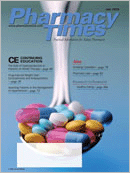Publication
Article
Pharmacy Times
Fed Up with Special Distribution Programs
I am fed up! You must be too. One ofour professional students presentedher project to our Pharmacy ExecutiveGroup, which entailed writing a specificpolicy and procedure for dispensinga drug that is available only through a"special distribution" program. In addition,she created a learning module sothat our entire staff could be "credentialed"for performing responsibilitiesrelated to the use of this drug in our hospitals.Listening to her presentation wasa tipping point for me, because we havebeen required to establish similar policiesfor a growing array of products,including dofetilide, bosentan, epoprostenol,treprostinil, iloprost,abatacept, natalizumab, sorafenib,sunitinib, omazumab,deferasirox, thalidomide, andlenalidomide.
These "special distribution"programs usually are createdby the pharmaceutical manufacturers,apparently endorsedby the FDA and most frequentlydefended on the basis ofpatient safety. The obviouscommon characteristic of mostof these agents is that they areincredibly expensive. Many ofthese programs require specificeducational or "credentialing"requirements for pharmacists,physicians, and/or nurses.Some programs require datacollection and submission, special packagingand storage requirements, and, frequently,a unique dispensing procedure.As a result, our staff and your colleagueshave to comply with a myriad of disparatepolicies and procedures, withwhich they must maintain familiarity onan ongoing basis.
I cannot dispute that educational anddistribution requirements of special distributionprograms reduce the potentialfor drug-related medication variances,but I suspect that they have been recommendedto the FDA by the manufacturer.I will let the readers speculate on whymanufacturers promote and implementspecial distribution systems and, further,why the FDA supports them.
I am baffled by the decision to imposethese extraordinary requirements onhospitals and their providers. As one ofmy staff members commented recently,quinidine probably would not achieveFDA approval today without a special distributionsystem. As far as having apotential for serious medication errors,chemotherapy, anticoagulants, thrombolytics,and scores of other agents haveprofiles similar to agents that requirespecial distribution programs.
Our hospital and its providers havedeveloped and maintained a highly effectivemedication management system forall drugs. Admittedly, we continuouslystrive to improve, because no process isconsistently perfect. I believe that creatingthese many new programs introducesopportunity for reducing access,delaying time of initial drug administration;consumes excessive resources; andadds cost to the health care system.
It is time to put a stop to the expansionof special distribution programs. I believethat manufacturers of drugs with specialdistribution programs should be heldaccountable to substantiate the valueand need for existing programs on anongoing basis. Finally, if the manufacturersand the federal government requirecompliance, which of the two will payhospitals for the additional resourcesrequired for compliance?
Mr. McAllister is director of pharmacyat University of North Carolina (UNC)Hospitals and Clinics and associatedean for clinical affairs at UNCSchool of Pharmacy, Chapel Hill.







